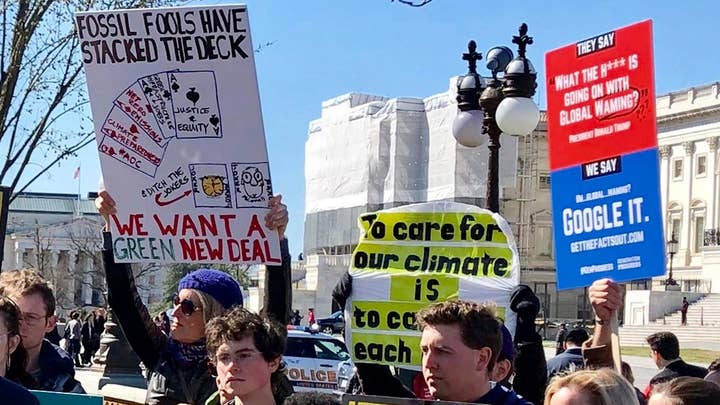Most Americans are now familiar with the so-called “Green New Deal” and its plan to save the world from the evils of atmospheric carbon by restricting cars, airplanes, and bovine flatulence at an astronomic cost to the American people.
I voted against moving forward with the Green New Deal. But beyond the fate of this particular bill or jokes about its content, it is worth addressing the policy goals and consequences of the Green New Deal on their own merits. These ideas are eternally popular among politicians who seek more government control over free markets and more power over people’s lives, and we will see them again one day in new clothing.
The Green New Deal is a 10-year plan to achieve net-zero greenhouse gas emissions, along the way promising to create millions of high-wage jobs and ensure economic security for all.
'EXTREME' DEMS WILL 'IMPEACH THE PRESIDENT ANYWAY,' TED CRUZ PREDICTS ON 'HANNITY'
While this may all sound unrealistically good, such grand promises come at a grand cost and an unthinkable level of intrusion of the federal government into the private lives and decisions of regular Americans.
Since the Green New Deal is unspecific about key details of how to achieve its goals, it has been difficult for experts to subject it to serious analysis. However, according to an estimate from the American Action Forum, the Green New Deal may cost between $51 trillion and $93 trillion over 10-years. To put that into context: $93 trillion amounts to around $10 trillion more than the entire recorded spending of the U.S. government since 1789, meaning it would cost each American family roughly $65,000 every year.
In artificially slamming down to a zero-emission country – regardless of whether such a move is even environmentally necessary – the Green New Deal promises to essentially destroy the American energy industry as we know it. In Texas alone, that means the almost 350,000 Texans employed by the oil and natural gas industry would lose their job. The $14 billion in state and local taxes and state royalties – which represents 29 percent of Texas’ gross state product – paid by the oil and gas industry would be gone.
The Green New Deal makes clear that Americans shouldn’t have a choice in the type of energy that keeps their lights on, runs their appliances, or provides cool air when it’s hot or heating during the winter. Calling for 100 percent of America’s electricity to be provided by zero-emission energy sources within a decade completely ignores the fact that wind and solar generated less than 8 percent of the U.S. energy needs in 2017.
It also ignores the vast reserves of natural gas in the United States, an abundant energy source that currently provides more than one-third of our nation’s energy needs. What the Green New Deal doesn’t want to talk about is how natural gas has replaced coal in massive amounts resulting in plummeting greenhouse gas emissions. This is especially true in Texas where natural gas now provides more than 50 percent of the state’s generation capacity.
In their singular focus on renewable energy, the authors of the resolution specifically exclude nuclear from America’s energy future. In addition to 20 percent of U.S. electricity being generated from nuclear, it is a zero-emission – that’s right zero – energy source. If the authors of the Green New Deal were being genuine instead of political, and really believed that carbon emissions would lead to catastrophic harm to the planet, they wouldn’t exclude nuclear energy: they would instead be promoting it.
Switching from our current energy sources to solely renewable means Texas households could be paying hundreds of dollar more per month in their electricity bill, just for this one aspect of the Green New Deal.
Along the way, the Green New Deal makes assumptions and promises that should lead every reasonable person to scratch their head, and imagine the massive disruptions that must ensue – for instance, replacing all air travel with high-speed rail.
Like all developing technologies that might give us a speedier, cheaper, and cleaner future, high-speed rail absolutely has its place in 21st century America, alongside all of its competitors also promising great things. To use an example from the private sector, the Tesla electric car is not forced on us by government dealerships; it competes in the free market. We should leave such things to the Elon Musks of the world, who seem very good at exploring such options on their own.
The Green New Deal also seeks to provide Americans “affordable, safe, and adequate housing,” a noble goal already pursued by HUD, a bevy of federal, state, and local agencies, and countless private charities. But this also includes a mandate to rebuild or retrofit countless houses, not merely so they are safe, healthy, and comfortable, but so that they meet the appropriate “green” requirements. Again, it is difficult to estimate the cost of something so generally sketched out, but estimates range to just over $4 trillion in cost. By comparison, the President’s proposed budget for FY2019 is $4.746 trillion. This isn’t the whole Green New Deal, remember, just the part about housing.
CLICK HERE TO GET THE FOX NEWS APP
When the Green New Deal was voted down this week, it was not simply an instance of Grinch-like accountants picking apart well-intentioned visions for a brighter future. I respect my Democratic colleagues enough to take their ideas seriously, and I was disturbed by how dangerous those ideas were to millions of hard-working Texans, and millions of families across America.
Instead, I’d urge my fellow senators to double down on the policies that are already improving countless lives, expanding economic opportunities, and saving the environment today. Giving innovators the space to create and improve technologies, and employers the leeway to grow and offer more good-paying jobs in our communities: these are deals that we can all get behind.






















